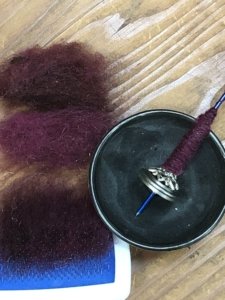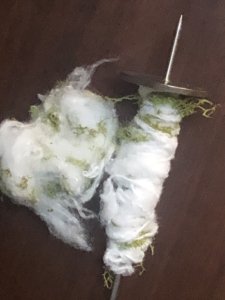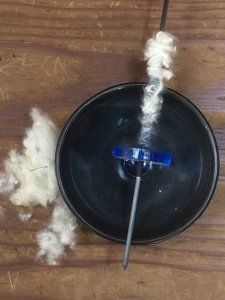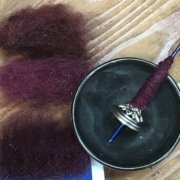Just Give It a Whirl
Words and Photos by Michele Marshall
“What if…?” might be the most exciting phrase in a maker’s world.
I have dabbled in various forms of fiber, paper, and mixed media arts for most of my adult life. In each creative endeavor, I’ve discovered “what if” often precedes an exciting and fun phase of exploration that extends my knowledge and enjoyment of my craft.
Put simply, I’ve made a lot of ugly stuff!
Okay, put graciously, I’ve made a lot of things that were “less than attractive” and had no purpose whatsoever.
The trick is learning to accept things don’t always work and to reflect on why they didn’t or what was learned in the doing. Then you figure out how to apply those lessons to future explorations or extend what you already know. It’s called playing, except as adults we have forgotten how much fun it is!
I know people who collect and use support spindles, and I had wondered why they felt the need for another spinning tool. Then I encountered cotton. While I can spin it, laboriously, on my wheel, I started to think “What if I tried cotton on a support spindle? Would it be more fun?” Support spindles are relatively inexpensive, so I acquired one (or more) and started with cotton. It went well, and I found cotton took no more time on a support spindle because I traded all that treadling time for drafting time.
But support spindles took me by surprise. I hadn’t really thought about what “supported” spindling really meant. It makes all sorts of “what if” options come alive! The single needn’t be strong, just able to hold together reasonably well.
“What if I try supported spinning?” became a minor fixation for me. I started a collection of things I wanted to try spinning on my support spindles when time and motivation allowed. I collected bits of moss, air plants, pharmaceutical cotton, clean dryer lint, finely shredded paper, steel wool, hand-combing waste, pygmy goat down, cottonwood seeds – and looked forward to a day to play.
One of the first things I considered was some of my materials might not be friendly to my traditional fiber tools. It’s one thing to expose the metal or carbon fiber shaft of a support spindle to something organic but quite another to consider putting those organic materials into, say, your hand cards or drum carder. Fortunately, I have a pair of cat combs I had purchased early in my cotton spinning explorations, both inexpensive and washable or disposable.

I started with some combing waste, mostly because I had a fair amount of it on hand from a recent spin. It was a bit neppy and soft, but also not something I had to worry about ruining. Think of it like the mud in mud pies; if it turns out well, you can always upgrade the ingredients! I decided to try blending it with steel wool. The steel has a longer “staple” length than my wool, so I added it to one card after I finished the blending, removing that batch without any rolling, like a batt. I added a second, wool only, blended “batt” on top and then rolled the two together from the side, rather than the tip, and drafted from the tip end.

I plied the single, creating a sparkly 2-ply yarn that is surprisingly strong. I certainly wouldn’t wear it, but it could make an interesting addition to a tapestry weaving or a needle felting project.
The collection of “what if” items itself taught me a few things, one of which is that sometimes you have to stop and play in the moment. While in Florida, I collected some air plants, thinking their short, flexible stems might be something I could spin. Sadly, I didn’t have a support spindle with me, and by the time I was able to get to my spindles, the plants had dried too much to be of use.
I had no such problems with the moss, which I tried spinning on its own, but it either broke apart with too much twist or refused to take twist at all. By blending the moss with cotton, in the same way I used the steel wool and combing waste, I got a passable single. The moss, however, became bruised in the process and eventually caused the cotton to weaken with dampness. It also made a mess, one I am glad I didn’t have to clean away from the moving parts of a wheel.

Some things that seem like they might be spinnable simply refuse to be spun on their own. Dryer lint was a disaster. I thought I could spin it just as it was, holding it loosely in my hand and letting my leader work some twist into the fluff.
Several sneezes later, I gave this up. There simply wasn’t any staple length at all to the fluff.
Combining a couple of “What if” ideas, I carded some pharmaceutical cotton, the type they stuff in the top of medicine bottles, with the dryer lint. With this blend, I made an interesting sort of Donegal tweed-like yarn. The lint isn’t terribly strong and tends to shed a bit, but it presents all sorts of interesting ideas about adding it to batts or carding it into singles. I started thinking about collecting “sentimental lint” from washing things like children’s clothes or old flannel shirts and realized I get a consistent beige-colored lint from washing flannel sheets.
The cotton/lint play taught me that not all pharmaceutical cotton is the same. The first bits I played with were very nice, much like the handspinners’ cotton I’ve purchased. The second bits, however, were bluntly cut, full of nepps, and lumpy. But these less-than-nice cotton pieces allowed me to see the fibers in the clumps move apart and into place when it double drafts, something I find particularly difficult to see in smoother preparations.
By now my spinning area was a mess. I had moss, lint, fluff, wool, and steel dust surrounding me. But I couldn’t clean up until I saw what I could do with the cottonwood seeds.

I was encouraged because, unlike dryer lint, the seeds have a staple. It might be only 1/4-inch long, but it is something to work with. On a whim, I tried spinning the seeds from their cloud. And it works! The single is soft and prone to breaking easily, but it’s a single. I started thinking about goose down. Haven’t I read that people used to weave with such things?
And what if I combine desirable seeds, dryer lint, and cotton? I think cosmos seeds might be a good candidate for the experiment. The cotton and dryer lint are biodegradable, and I’m told wool makes good compost, too. What if I use a little square loom and make the base from the cotton/lint/seed single and then do the final weaving with a fine wool single? What if I planted and watered this square? I could mail them to family and friends in their birthday cards.
I have so many more options I want to try, ideas generated through playing with inspiration and materials. Playing opens up our stash, and our minds, to potentially exciting discoveries. It gives us new muscle memory for taking into our default and new spins. And it makes spinning a never-ending rabbit hole of exploration and possibility.
Now, go play in your stash!

Michele Marshall has always been fascinated by people make things and usually has to try it herself if give half a chance. She lives with her husband in the hills of Indiana and can be found on Ravelry as Mingo08.




Great article! I would have never thought of spinning most of these. Thanks for opening up my eyes!
Thanks, Denise! We should have brainstormed together on NYE!
We should have brainstormed on NYE! Thanks, Denise!
Very enjoyable read, Michelle! I can’t say I’ve never thought about spinning dryer lint, but I have spun with pharmaceutical cotton successfully. You’re so right – it varies a great deal.
Playing with different fibers is all part of the fun of creating. And yes, it all starts with, “What if?”
Thanks, Mary! There are so many ways to stretch ourselves if we let go of expectations!
As a trained preschool teacher, this is an excellent reminder that many of the physical tasks we learned as children were usually learned by playing and pretending.
I also second the idea that any spinning we do improves us in a later task. When we are finding drafting difficult, switch fibers for a while, then come back later. It’s often easier the second or third try.